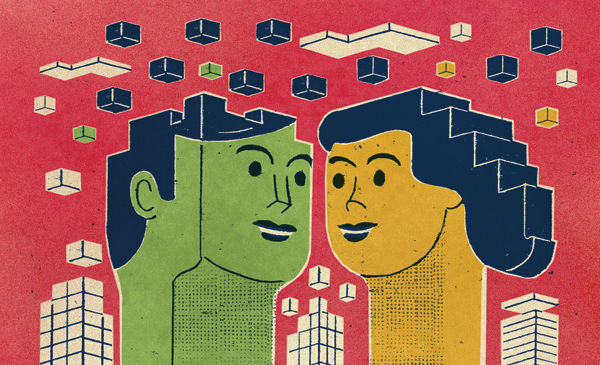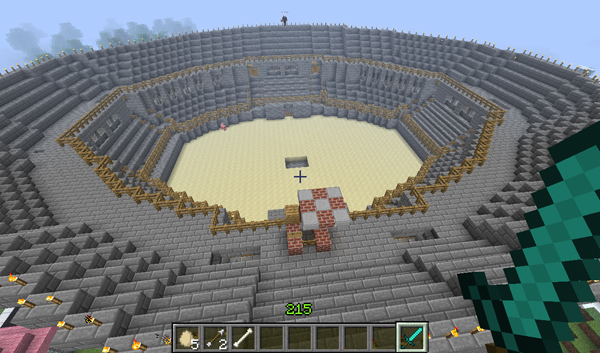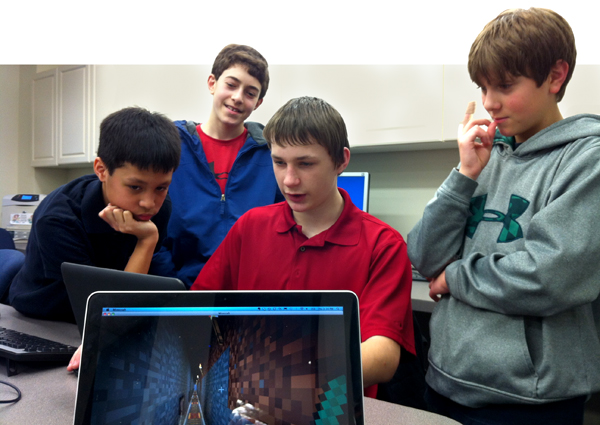
Illustration by David Plunkert.
By Sarah Ludwig
Lately, there’s been more drama than usual in our library. At the moment, one of my students is swapping some diamonds—yes, diamonds—for a hefty amount of railway ties. Another is secretly plotting to swipe an unsuspecting classmate’s body armor. And a group of friends can’t believe their luck: they’ve just stumbled across a trove of valuable chests in an abandoned mineshaft.
Welcome to our Minecraft club. Every Friday afternoon, 28 middle school and high school kids get together in our library’s computer lab to feast on candy and play one of the world’s hottest video games.
What exactly is Minecraft? It’s a game in which players use three-dimensional blocks to build their own unique world. Minecraft began as the brainchild of Swedish programmer Markus “Notch” Persson, and an early version of it was originally released in 2009. Nowadays, the game is available in an iOS, Android, and an Xbox 360 version that’s published by Mojang, a Stockholm-based video game developer. According to the Swedish company, more than nine million people have purchased Minecraft, and as I write this sentence, 9,610 fans have bought it within the past 24 hours. Think of the game, as Wired magazine said, as “a virtual version of Lego” that has “no instructions, no levels, no mission structure, no story, no lives, no points, no clear goal.” So what does Minecraft have to offer? Well, as it turns out, plenty.
For starters, kids can construct whatever they want—anything from an inconspicuous igloo to the starship Enterprise. But more than that, the game lets players exert an enormous amount of control over the worlds they’ve created. For instance, skilled players can get extremely creative with the materials at hand, which commonly include wood, stone, and metal, transforming or (in Minecraft-speak) “crafting” them into tools, weapons, food, supplies, and even magical potions. When you set up a server for Minecraft, you can tweak its settings, but for the most part, the worlds are huge—about eight times larger than Earth—with various biomes, including deserts, snowfields, and jungles. Players create their own shelters and explore the world. They also lug around a variety of objects—including torches, weapons, armor, mining tools, and prepared food—to keep themselves well fed and safe from other players and predators (more on that later). It’s easy to move around in Minecraft: just press the “W,” “A,” “S,” or “D” keys. Need to suddenly leap into the air? No sweat. That’s where the space bar comes in handy, and by simply left- or right-clicking, players can effortlessly interact with their environment.
I confess: I wasn’t always wild about Minecraft. Like other technology that I’d put off trying, the game intimidated me. It seemed like Minecraft was solely for supergeeks and hardcore gamers. And while it’s true that I’m still a little intimidated by Minecraft, the game is accessible, fun, and, ultimately, an excellent learning tool for both nerds and non-nerds. In January, my colleague Chris Buckley and I launched a Minecraft club at the Hamden Hall Country Day School, a private pre-K–12 school in Connecticut. Chris is our school’s help desk technician, and he’s also a lot of other things, including an ethical hacker, a maker, a sharer, and (lucky me!) a server builder.

Screen Shot of the Minecraft club’s creations.
Taking the plunge
The world of Minecraft offers some lovely sunrises, but things get really interesting when night falls. That’s when the spiders, zombies, skeletons, and other assorted monsters come out. To avoid being killed by these menaces, players must make fires, create weapons, and construct shelters, which are typically multistory wood or stone structures with storage chests, a crafting table, pets, farms, and farm animals. Sometimes our kids really outdo themselves, and their home bases have also included towers, castles, pyramids, and even a spaceship.
In a multiplayer server like ours, the operator (Chris and I are our server’s ops) can set it to any of the following difficulty levels: peaceful, easy, normal, and hard. In the peaceful setting, players can’t fight with one another and don’t have to eat, and there aren’t any monsters. I’d recommend that librarians start their servers on peaceful. That way new players can get the hang of building things and forming allegiances without having to worry about surviving a hostile attack.
Minecraft also features several game modes. If you’re a newbie like I was, you’ll want to check out the creative and survival modes. The creative mode is a lot like the peaceful setting: it’s perfect for exploring and building, because there are no gnarly creatures, no player-versus-player, or “PVP,” fighting, and no need to consume calories. It’s a perfect starting place for you and your kids, but you probably won’t want to stay there for very long.
Although some of our students prefer this tranquil state, most of them relish the opportunity to fight—and that’s one of the reasons our server is now set on survival. In this more-challenging mode, every time players slay a monster, they accumulate experience points, or xp, which enable them to enchant materials (how about a pickax that breaks rocks faster?) or create magical potions, which can temporarily grant players invisibility, Herculean strength, or lightning-quick reflexes. If you want your kids to be able to set up communities, trade (and fight) with one another, and battle monsters, survival is the way to go.
During my first few weeks with Minecraft, I logged on whenever I could, and my students gave me lessons in building structures and crafting. One of them helped me build my house and another showed me how to plant crops. Sometimes I’d log in and discover that they’d left me gifts of food or gold. Because I’m an op, I can make things a little easier for myself, but I try not to take any shortcuts, because I want to learn how to play the game. Still, it helps to have a partner who’s an experienced Minecrafter, who can advise you on the finer points of administering a server. If I didn’t have Chris, I’d most likely recruit one or two of our most trustworthy students to help me run things.
When we first started our server and began meeting, the students treated it as a virtual society: they claimed land, built cities, appointed a leader for each city, began trading, and took on various societal roles. It was fascinating to watch. Our students completely governed themselves, and they had a strong sense of right and wrong. For example, damaging or stealing materials from other players (a practice known as “griefing”) was firmly discouraged and met with swift punishment.
In addition to society building, one of my favorite things is to develop challenges for our students. It’s a great way to spend our weekly meeting time together. One week we created an obstacle course—complete with lava and water pits—that requires players to clear difficult jumps and walk a tightrope. Some of our kids created a coliseum where players can practice fighting monsters or one another to sharpen their combat skills. I also created a scavenger hunt with clues hidden throughout the server that led to a secret chest of diamonds. Each one of these activities involves a ton of planning, communicating, and delegating, with players jumping in to help one another.
What we’ve learned
In the few short months that I’ve run our club, I’ve learned some important lessons. One is that middle school and high school kids don’t always get along well. After repeated instances of griefing, stealing, and fighting, we duplicated our original server so that each group would have its own. Now there’s far less bickering. I’ve also learned that one way to avoid inappropriate language, cheating, and poor gamesmanship is to keep an eye on the server logs, which include everything that’s said on the server as well as many of the actions. By monitoring the logs, we can make sure that students are acting appropriately, and we can temporarily ban those who aren’t. We’ve also learned to limit the hours the server is open. Now, it’s off during the school day, and it shuts down again in the late evening. Since we’re a school, we need to make sure that our students aren’t playing Minecraft when they should be studying or sleeping.
One challenge we haven’t found an elegant solution for is in creating student accounts. Players each need their own account to participate, and at $26.95 apiece, they’re expensive. MinecraftEdu, a small group of educators and programmers, offers educational discounts, but even those are almost $20. Many of my students already had their own accounts, but those who didn’t ended up shelling out their own money—even though I offered to purchase accounts for them with my programming budget.
Minecraft is a social activity that’s fun for kids to play with one another (and in many cases, make new friends), but the game also offers a host of learning opportunities. Most strikingly, it requires kids to collaborate. Unlike some of the assignments we educators create to force kids to work together, Minecraft requires an organic type of collaboration that’s managed by the students themselves, not by their teachers. Minecraft also fosters communication skills, as players type, guide their fellow players around, and even create message boards.
Since there’s practically no limit to what players can do with Minecraft, it encourages creativity big-time. As players grapple to solve myriad problems—everything from the complex (how to create a lever system that lifts players into an arena) to the simple (how to get an ocelot to follow you home)—they are developing communication, analytical, and social skills that apply to nearly every area of their lives. Perhaps not surprisingly, Minecraft can also be used to teach everything from science to writing to math. The possibilities are endless. For some great examples of lessons, activities, and tutorials to use in the classroom, visit MinecraftEdu.
Just a few hours before I wrote this, I logged on to Minecraft and noticed that two of our ninth graders were playing it. One of the boys showed me a roller coaster he’d just finished creating. I hopped into one of the carts, pressed a button, and off I went—zipping through glassed-in underground tunnels, up steep hills, and through passageways lined with lava. This student, who struggles in some of his classes, had completed something remarkable, an engineering feat that a vast portion of the population could never equal. As I rode along, he tweaked the track here and there, making sure that everything ran smoothly. “This is amazing!!!!” I typed. I hope he’s proud. Minecraft is a game, but it’s not just a game. It gives students the opportunity not only to dream big, but also to build big. And if, along the way, you get to talk a little smack and be a little silly, then all the better.
 Sarah Ludwig is the library department chair and academic technology coordinator at Hamden Hall Country Day School, a pre-K through grade 12 independent school in Hamden, CT.
Sarah Ludwig is the library department chair and academic technology coordinator at Hamden Hall Country Day School, a pre-K through grade 12 independent school in Hamden, CT.




Our tech teacher set up a Minecraft server earlier this year, and one of my favorite students came in a few weeks later super excited. He dragged me into the computer lab across the hall and, full of pride, gave me a tour of the libraries he’d built in Minecraft. It was fantastic, and he went on to build two more – along with all the other things he built – like a model of the Parthenon. The best part is that the libraries were full of books in certain sections, and comfy seating as well.
Do you have to be a Minecraft player to run a club in the library? My students love it and I’d like to give them the opportunity to play together in the library, but I’m not sure that I want to spend the time to learn the game and play it myself. I already know which of the students I would invite to be the player leader is, but do I have to be an active player as well?
I don’t think you need to be a player to get it going, but it is well worth it to learn the game so you can come up with ideas for using it. The format of Minecraft really allows the imagination to run wild, but it can be difficult to grasp the purpose and intent of the game without playing it. I know I had a hard time conceptualizing it until I spent a few hours poking around and building things.
Great story! We did a Minecraft summer camp and hope to try it again this summer. Knowing just how interested students were in this game (much to the chagrin of some teachers and parents), we decided that we definitely could not beat them, so decided to join them. Watching the excitement, creativity and the collaboration among the students gave me a deeper respect for the game.
This year we have seen the use of MinecraftEdu spread into the general curriculum with students doing projects like recreating early American settlements.
Teachers who want to know more about the game or to offer a low cost, offline manual for their students might want to consider Minecraft for Dummies, published earlier this year by Wiley and written by a 15 year old.
My son a Gage is amazing at this game minecraft he is only 6 yr old I’m looking for a camp or library program for him
I love the idea of a minecraft club in the library where I work. But just so you know minecraft worlds are endless, they will continue to generate no matter how far you explore, not 8 times larger than earth.
A fun way to let your students learn and play minecraft teach them the lesson on minecraft